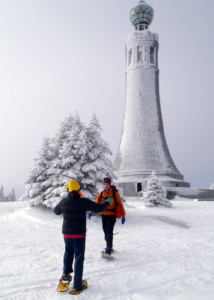
Here at EasternSlopes.com, none of us are heroes. We are just people (like you) who enjoy getting outdoors and finding fun alone or with our friends (old and new) and our families. That’s why we share our stories, hoping to inspire you to all do more in the outdoors.
In Aiming High: Summiting The High Points of Massachusetts, New York, Vermont, New Hampshire and Maine In All Seasons, I outlined a personal goal; I want to climb to the highest summits of Massachusetts, New York, Vermont, New Hampshire, and Maine, and I want to do them all in winter, my favorite season. The five high points are Mount Washington (6,288 feet) in New Hampshire, Mount Marcy (5,344 feet) in New York, Mount Katahdin (5,268 feet) in Maine,, Mount Mansfield (4,395 feet) in Vermont, and Mount Greylock (3,488 feet) in Massachusetts. Some of these mountains, of course, are easier than others, but they are all within reach of most of us if we just set our minds to it.
Greylock is the smallest and the easiest. That makes it a good starting point—if you are in reasonable shape, you can pack a few essentials for safety and comfort in your backpack, pick a good day and go. You can park right at the base of the mountain and there are a number of routes to choose among, most climbing about 2,300 vertical feet. Sure, Greylock can be made more challenging—just pick a longer and more difficult route or go when the weather’s not so nice. But that’s not the point . . . not the first time, at least. Though I’ve climbed other hills in the Berkshires, my only prior ascent of Greylock had been while doing a section hike on the Appalachian Trail. That had been in September, in hurricane force winds and driving rain–I hadn’t lingered to enjoy the view.
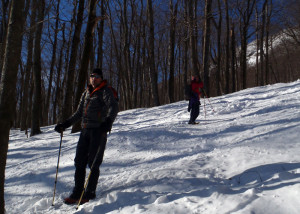
Winter On Mount Greylock: January 03, 2013, Sub-Zero Start
It was -9° F. as I drove through North Adams, Massachusetts, and -4° F. when I parked my car higher up at Greylock Glen, just west of Adams. Perfect weather for climbing the highest mountain in Massachusetts, don’t you think?
Back in December of 2011, I had a story published in the Berkshire Eagle newspaper about my dream to stand atop the highest points of Maine, New Hampshire, Vermont, New York, and Massachusetts in winter. That’s how I met my new friends from Pittsfield, “Sweep” Voll, and Steve McDermott, who were as enthusiastic as I was about climbing Greylock in January. Sweep, who describes herself as a “lover of all things outdoors,” read that column and invited Steve and me to join her on her backyard mountain. While a “guide” is hardly necessary on Greylock, having someone who knew the trails and the local history made the experience just that much more fun.
The day we picked just happened to be the coldest in two years. . . . but that suited me just fine. I’d much rather climb a mountain in subzero temps than the heat of summer. We parked just below Gould Farm (be sure to respect the private property and no trespassing signs), laced up our boots, checked our packs, took a few deep breaths of air so cold it felt almost brittle, and started up.
Winter On Mount Greylock: Gearing Up For The Cold
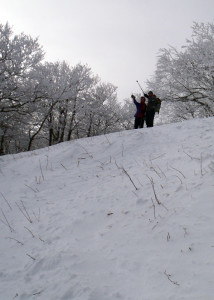
Our planned route would take us up a variant of the Bellows Pipe Trail to join the Thunderbolt Ski Trail, the most direct route to the top. Because of the intense cold, we’d decided to keep things simple and just hike up and down instead of bringing skis. Turns out the snow was deep enough for good skiing and, while I appreciated not having to skin up or carry the skis up the hill, I surely missed the fun and excitement on the way down. Next time . . .
Winter is a time of rapidly changing trail conditions and even a relatively small mountain like Greylock can present variable conditions which make for very interesting challenges. A week before this jaunt, I’d climbed on Mount Monadnock in southwestern New Hampshire to start the process of breaking in my new Lowa Mountain Expert winter mountaineering boots, and the upper mountain had presented a sheet of hard, blue ice, impossible to negotiate without aggressive traction aids. The snow was much deeper and softer on Greylock. Sweep decided to wear her tried-and-true Atlas aluminum-framed snowshoes and carry Kahtoola MICROspikes in her pack. Steve and I both carried snowshoes on our packs in case the snow was too deep for easy walking, his a pair of aluminum-framed Tubbs, mine MSR Evo Ascent molded plastic mountaineering snowshoes. As we climbed we both wore traction aids on our boots: MICROspikes for him, Hillsound Trail Crampons for me. We all had trekking poles, as well.
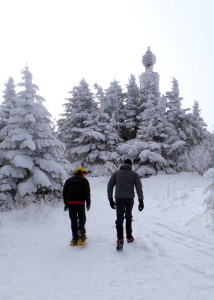
It hadn’t snowed significantly for several days, and the Bellows Pipe and Thunderbolt Trails were well packed by earlier climbers. Both the snowshoes and the traction aids had their drawbacks, but at different spots on the mountain. In places where the wind had blown in deeper powder, Steve and I both punched through the packed trail surface and sank in to our knees. But in other spots, where the wind had blown the snow off leaving ice below, our crampon-like cleats gave us better traction than the cleats on Sweep’s snowshoes. In all, it about balanced out but a slight change of more or less snow or a different consistency would have favored one or the other, so it made sense to have both along.
We all carried extra layers of insulation and windproof outer shells. You aren’t going to need a lot of warmth going up unless it’s really, really cold, but you sure will on top and coming down. Though the day had warmed considerably by the time we reached the top, the wind had picked up and we all added several layers at the summit and kept them on for the descent.
We also carried snacks and insulated bottles of warm water in our packs. I always have a small vacuum bottle of hot tea when it’s really cold. And, because it was so cold, and because it’s who I am, I also threw a lightweight synthetic-fill sleeping bag and a bivvy sack into my pack and strapped a Z-rest pad to the outside. That setup (less than five pounds of extra weight) could keep an injured hiker warm and safe until rescue. Even a civilized “little” mountain like Greylock demands respect in sub-zero weather.
Going Up . . .
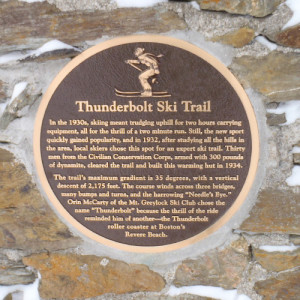
Like many New England mountains, Greylock is kind to you—for awhile, at least. The lower slopes are pretty gentle as you stroll through second-growth woods past the remnants of a ski area that never opened. We found tracks of deer, fox, and one member of the weasel clan; from the size. I’m guessing possibly a long-tailed weasel. This woodland stroll is a nice, gentle prelude to the real climb. By the time we actually reached the Thunderbolt, we weren’t noticing the cold at all. In fact, I was stripped to just a lightweight wool zip-neck shirt with a quilted vest over it.
Once we hit the Thunderbolt, the real climb started…you cross a narrow bridge over a stream and immediately head UP. Sections of the trail have names like “Big Schuss,” and “The Steps,” which gives you some indication of how steep they are. The footing was good and, without rushing, we reached the summit a little less than two hours after leaving our cars. Like most New England mountains, the views on Greylock get better the higher you climb, so we always had an excuse to stop a moment to “admire the view” and let our heart rates settle a bit.
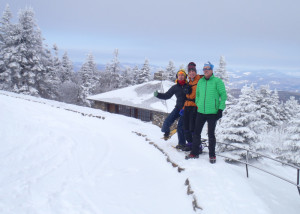
Just shy of the summit, we ducked into the (very cold) warming hut to get out of the rising wind, and put on extra layers for the (very cold) stroll to the summit. You haven’t climbed Greylock until you’ve touched the spectacular 93-foot War Memorial Tower on top. The tower is closed in the winter, and was covered in rime ice. It looked ghostly, even in the bright sunlight. At the tower, we bumped into another outdoor friend of Sweep’s, Matt Albert, who had snowshoed up another route. Looking away toward the northeast, we saw Mount Monadnock clearly (surprisingly close) and immediately began planning a summit attempt for the next severe cold spell. Then, we all shared a cup of hot tea in the warming hut, packed up, and headed down together.
Winter On Mount Greylock: Going Down
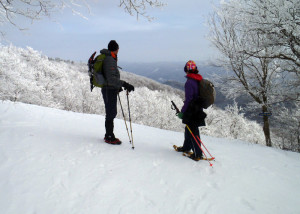
Anyone who has ever climbed a mountain knows this essential truth. While going up can be hard on the thighs and lungs, it’s going down that’s toughest on the knees. And going downhill is often more dangerous. That’s because it’s usually much easier to control your speed on the ascent. Slow is safe on steeps.
On the way down Greylock , the two snowshoe-wearers (Matt and Sweep), slid and tumbled several times as their snowshoes lost traction on the steepest inclines. Wearing aggressive traction aids, Steve and I never tumbled, though we did have to be very, very careful in spots where we were likely to punch deep into the snow. You don’t want to have your leg plunge into deep snow and your momentum carry all your weight forward onto the knee. That’s a recipe for serious injury. But overall, coming down was easy and pleasant, and the day had warmed nicely.
All in all, Greylock on a sub-zero morning was exactly as I’d hoped it would be: a lovely and rewarding climb to the highest point in Massachusetts, well worth doing in its own right. It’s also a perfect warmup for the bigger hills to follow if you decide to climb all the high points in the northeast.


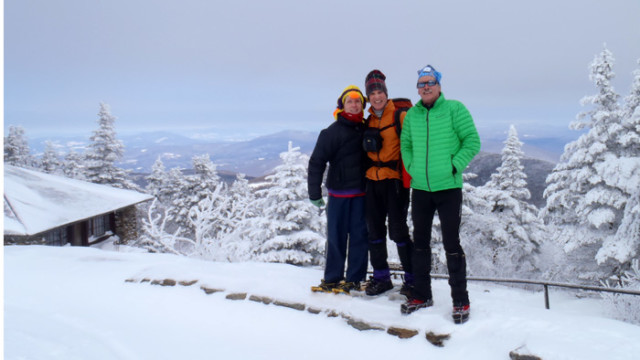
I enjoy reading posts of winter backcountry experiences, really helps readers formulate plans and properly prepare. One thing I’d like to share. Trails like the Thunderbolt were designed for down-mountain skiing. There are a number of hiking trails to the summit of Greylock. When hikers (on snowshoes) use down-mountain trails it changes the surface texture of the snow making the skiing less enjoyable and sometimes ever dangerous after a thaw/freeze cycle. These old CCC trails were cut narrow to hold the snow and I can’t tell you how many near misses I’ve had skiing down a ski trail while someone is walking up, with a hiking trail within a short distance. If the ski trail is the only route up, there’s not much you can do except stay to the sides. With possibly Mt. Marcy as an exception, there are generally hiking trails to ascend and descend, leaving the ski runs for skiing. This probably sounds cranky to a snowshoer but there are a limited number of down-mountain ski runs in the Northeast but an unlimited number of hiking trails to utilize. Just one BC skier’s opinion and plea.
Joseph,
Thanks for writing and your point is well taken. It would be nice if more trails could be designated for downhill skiing and snowboarding only, with appropriate signage and routes designated for hikers and skinning up. The Sherburne Trail down from Tuckerman Ravine is a perfect example; everyone hikes and skins on the Tuckerman Ravine Trail, skis or boards down the Sherbie. On the steepest sections of Marcie, there are separate ski and hiking trails, and that works well, too.
But it isn’t always possible to have separate trails, and sometimes, especially after a heavy snowstorm, it’s necessary to skin up the trail you intend to ski down to check for fallen branches buried under the snow.
Impact on snow quality is inevitable on multi-use trails, but it isn’t confined to potholing hikers and snowshoe tracks. Skiers who sideslip and snowboarders who “willow leaf” down steep sections probably have more overall impact on the “pure” backcountry experience. It’s why we get up early on a powder morning . . .
I suppose the only real solution is courtesy and common sense. If climbers kept as much as possible to the sides of the trails (or even in the woods), switchbacked only when absolutely necessary, and kept a sharp lookout for people descending, most conflicts would simply disappear.
Hope to see you on the trails this winter!